UC Gardening Blogs
Lovin' the Insects and Spiders? Visit the Bohart's Online Gift Shop
"Spiders are everywhere," Professor Jason Bond told the crowd at his April 2019 town-hall...
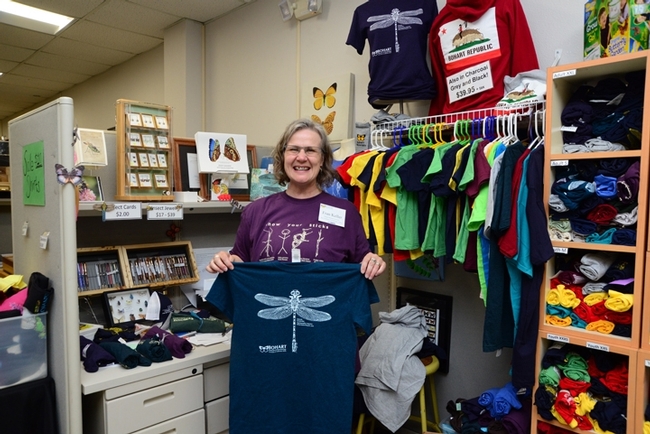
Museum scientist Fran Keller in the gift shop of the Bohart Museum of Entomology. A professor at Folsom Lake College, she is an alumnus of UC Davis, with a doctorate in entomology. (Photo by Kathy Keatley Garvey)
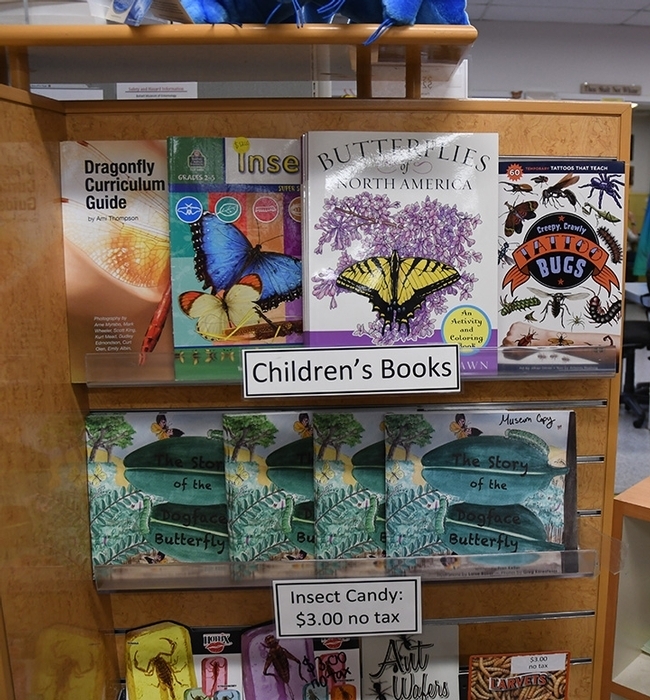
Books for all ages are shelved in Bohart Museum's gift shop, now online. (Photo by Kathy Keatley Garvey)
Detecting and Controlling Biting Mites Within Structures
Most pest management professionals have served clients who swore they were being bitten by unseen...
Noted Biodemography Book to Be Translated in Japanese Language
More than 120 million people who read the Japanese language will soon be able to read a newly...
An Interview with a Budding Gardener
The day after Thanksgiving, I had the privilege of interviewing a seven-year-old future home gardener and would like to share our conversation:
Elvie: I have today a young girl and she would like to tell us something about herself.
Lina: Hello, my name is Lina; I am seven years old and I like to read and play dominoes and arranging and rearranging flowers and succulents.
Elvie: Where do you go to school, Lina?
Lina: I go to school at CMP Montessori Project in Sacramento and I am in second grade.
Elvie: So how do you like on-line school?
Lina: It's ok; I think that going to real school is way more fun but on-line is ok, too, I guess.
Elvie: After on-line school is over, how do you spend the rest of your day?
Lina: Most of the time I just read a book and walk around the house when I'm bored; but when I just have nothing to do I just go outside and, yeah.
Elvie: Do you like to garden?
Lina: Hmm uh (nodding her head). I especially love kitchen flowers and getting succulents and just making a little pot of them and make it pretty.
Elvie: And what got you interested in gardening and what is your favorite flower?
Lina: My favorite flower is the Morning Glory and what got me interested in gardening is I just like getting dirty in the garden and mmm, I just like it. I'm not sure why but I like it.
Elvie: Do you like sunflowers ‘cause I know you love sunflowers.
Lina: Hmm, uh (nods her head again). Well, I like how they grow big and tall and they are really pretty; it don't care that they don't have a yellow middle like most flowers but it has a black middle and the black middle are seeds that you can eat and they are really delicious.
Elvie: And who taught you how to grow flowers?
Lina: My dad did and my Lola* and my dad taught me how to dig up stuff and plant them and my Lola taught me how to arrange stuff in a pot.
Elvie: Hmm, uh and what is your favorite vegetable?
Lina: My favorite vegetable that my Lola grows is sugar snap peas. I'm not sure if they're vegetables….
Elvie: Yes, they are, they sure are. They are vegetables; yeah.
Lina: I also like carrots that are grown from my garden ‘cause they taste really, really good; way better than the ones they sell at Trader Joe's.
Elvie: So do you think when you grow up you will be a home gardener?
Lina: Hmmm, I don't know; yeah, I want to.
Elvie: You want to! (smile on my face). And tell us about this TV show that you watched that talks about flowers. How did you find out about that?
Lina: Oh, it's called the StoryBots on Netflix Kids and it's about these robot ‘thingys' that live inside a computer and then kids ask a question and they have to find it out by going to the real world and not just stay cramped in the computer.
Elvie: And what was the question that one girl asked?
Lina: Huh, how do flowers grow?
Elvie: So how do flowers grow? Did you find out by watching?
Lina: Hmm uh. Well, they start out as a seed, and then they use water, sun, and air that go into the soil. It takes a bit of time to have the, hmm, the roots grow and then a sprout pops up and then it just keeps on growing and growing the big stem and then the bees come and get the pollen in the flower then get it up to the top with this long, yellow thingy...
Elvie: The pistil.
Lina: The pistil yes; and then the pollen goes through the pistil like inside the flower bed which holds more seeds so when the pollen gets into the seeds they drop and then the whole cycle starts all over again.
Elvie: And the sun helps too, right?
Lina: And water and air.
Elvie: Yeah, yeah. Do you know how they make food? What's that process called?
Lina: Meta…morphosis?
Elvie: Photos..….
Lina: Ah, what?
Elvie: Photosynthesis.
Lina: Photosynthesis, yes, I get that mixed up all the time. And then they combine together and make its own sugar for food and then it goes into the flower plant.
Elvie: So the sunlight, carbon dioxide, water come together in the leaves of plants to make food that becomes sugar that is absorbed by the leaves, which goes into the stems, and the main stem of the plant all the way to the roots so the plant can grow and keep growing. That's wonderful, isn't it? Did you learn a lot from watching the video?
Lina: Hmm, uh. I didn't really know that it used air too; I learned a little bit of that from school but then I just completely forgot.
Elvie: I am so glad you are very interested in learning all good things about growing flowers and gardening. Maybe you can visit again next spring after the pandemic and help Lola plant spring flowers and vegetables.
Lina: Good idea. Can we plant some sugar snap peas?
Elvie: Sure, sure, and sunflowers, too.
Lina: Yay!!!!
Elvie: Thank you for your time of sharing, Lina. Can you give Lola a hug?
And we hugged tightly (with masks on). BTW, Lina is my seven-year-old granddaughter. They came over for Thanksgiving.
*Lina calls me Lola which is grandma in Tagalog.
No Federal Protection for the Monarch Butterflies
Yes, monarch butterflies qualify for the Endangered Species list. But no, we can't protect them...
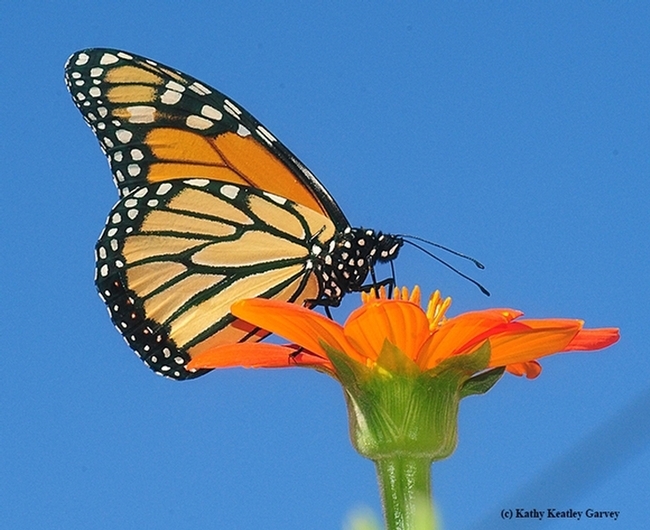
A monarch butterfly nectaring on a Mexican sunflower, Tithonia rotundifolia. (Photo by Kathy Keatley Garvey)
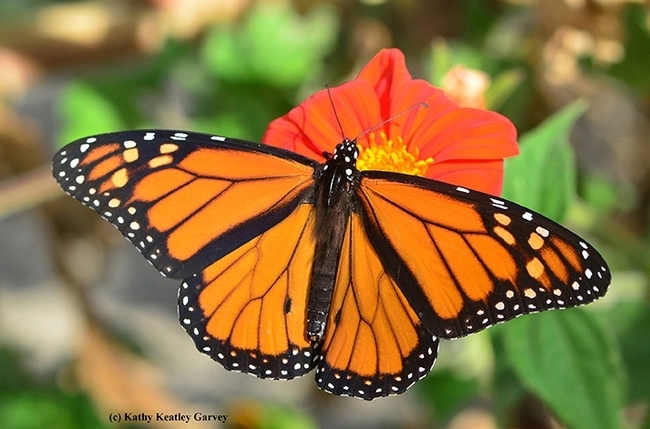
A male monarch spreads its wings as it nectars on Mexican sunflower, Tithonia rotundifolia. (Photo by Kathy Keatley Garvey)
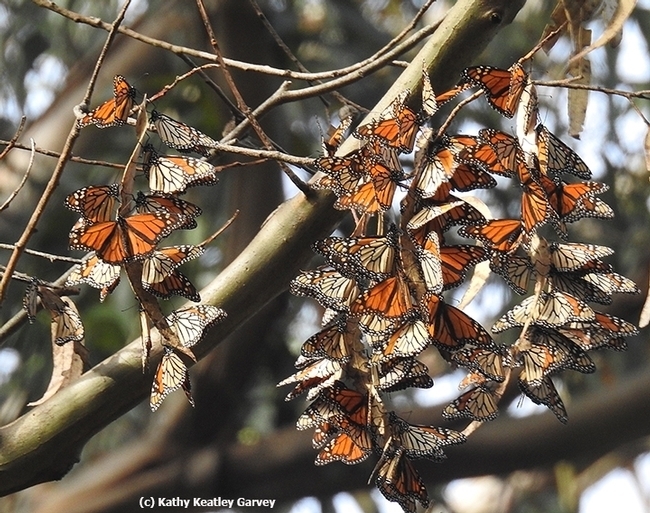
Monarchs overwintering in the Natural Bridges State Park, Santa Cruz, in 2016. (Photo by Kathy Keatley Garvey)




